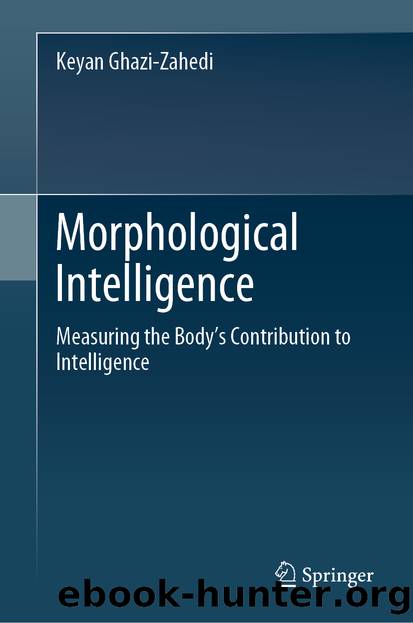Morphological Intelligence by Keyan Ghazi-Zahedi

Author:Keyan Ghazi-Zahedi
Language: eng
Format: epub
ISBN: 9783030206215
Publisher: Springer International Publishing
Definition 3.7
() Let the random variables denote the action, the current and the next sensor state of an embodied agent, which is described by the causal diagram shown in Fig. 3.4. The quantification of the morphological intelligence as an associative measure of the negative effect of the action is then defined as:
(3.63)
The Kullback-Leibler divergence used in the definition of (see Definition 3.7) is also known as the conditional mutual information and the transfer entropy of A on S [60]. It was investigated in the context of information self-structuring of embodied agents by Lungarella et al. [66].
Following the idea of (see Definition 3.6), the second variation is based on measuring the causal information flow of the sensor and action states S, A on the next sensor state . To simplify the argumentation, we first consider a reactive system (see Fig. 3.4). The measure will then also be presented and discussed for non-reactive systems, as both cases result in different measures. The idea for this measure is captured in Fig. 3.7. Note, that the sensor states S and are here understood as internally available information about the system’s environment. The causal information flow from S to , denoted by , includes the information that flows from S to over all pathways. This explicitly includes the information flow from S to over the action A (see Fig. 3.7a). Morphological intelligence is here understood as the causal information flow from S to excluding the causal information flowing from the action A to (see Fig. 3.7c). Hence, we need to subtract the causal information flow from A to , denoted by (see Fig. 3.7b) to exclude it from such that we receive the causal information flow that goes from S to without passing A, denoted by (see Fig. 3.7c). The derivations are analogous to the derivations required for (see Sect. 3.3.2).
Fig. 3.7Visualisation of the causal measure . The causal graph used in the Figs. (a), (b), and (c) is the reduction of the sensorimotor loop shown in Fig. 3.4 to two consecutive time steps. Figure a shows that the causal information flow measures all causal information from S to , including the information that flows over A. Figure b shows that the causal information flow only captures the information flowing from A to . Both can be used to approximate the causal information from S to , that does not pass through A, denoted by , as shown in Figure (c)
Download
This site does not store any files on its server. We only index and link to content provided by other sites. Please contact the content providers to delete copyright contents if any and email us, we'll remove relevant links or contents immediately.
Algorithms of the Intelligent Web by Haralambos Marmanis;Dmitry Babenko(8522)
Test-Driven Development with Java by Alan Mellor(7371)
Data Augmentation with Python by Duc Haba(7272)
Principles of Data Fabric by Sonia Mezzetta(7017)
Learn Blender Simulations the Right Way by Stephen Pearson(6953)
Microservices with Spring Boot 3 and Spring Cloud by Magnus Larsson(6783)
RPA Solution Architect's Handbook by Sachin Sahgal(6185)
Hadoop in Practice by Alex Holmes(6030)
The Infinite Retina by Robert Scoble Irena Cronin(5888)
Jquery UI in Action : Master the concepts Of Jquery UI: A Step By Step Approach by ANMOL GOYAL(5872)
Big Data Analysis with Python by Ivan Marin(5707)
Life 3.0: Being Human in the Age of Artificial Intelligence by Tegmark Max(5402)
Pretrain Vision and Large Language Models in Python by Emily Webber(4669)
Infrastructure as Code for Beginners by Russ McKendrick(4449)
WordPress Plugin Development Cookbook by Yannick Lefebvre(4178)
Functional Programming in JavaScript by Mantyla Dan(4123)
The Age of Surveillance Capitalism by Shoshana Zuboff(4115)
Embracing Microservices Design by Ovais Mehboob Ahmed Khan Nabil Siddiqui and Timothy Oleson(3966)
Applied Machine Learning for Healthcare and Life Sciences Using AWS by Ujjwal Ratan(3942)
